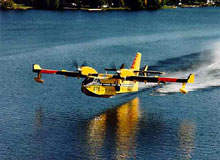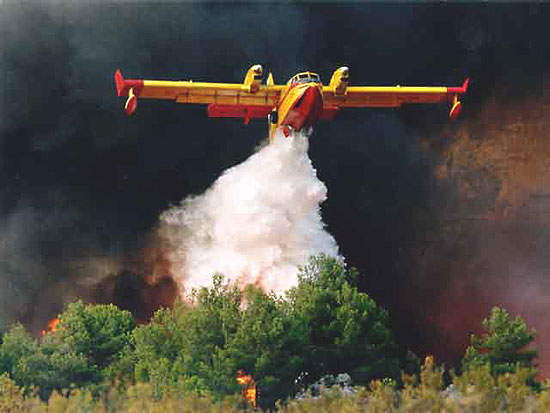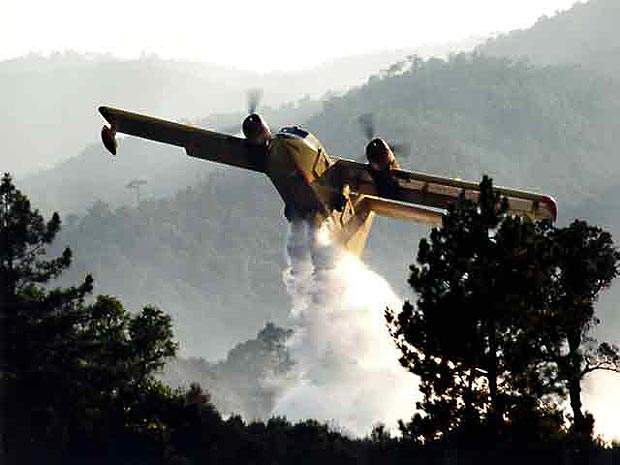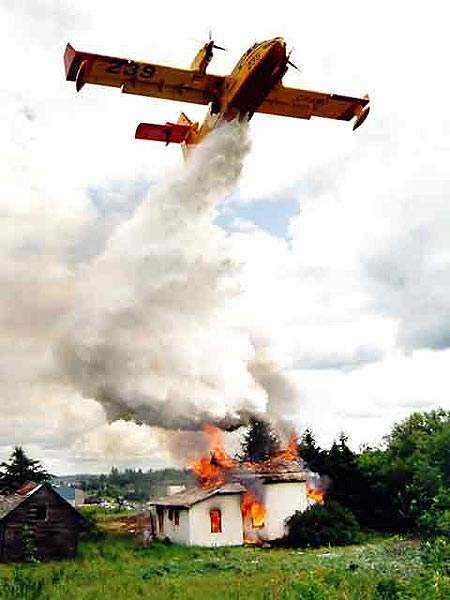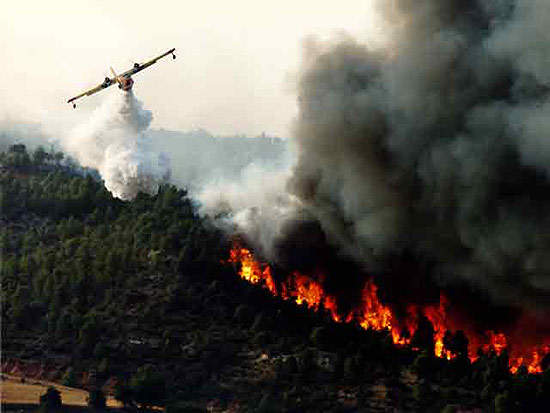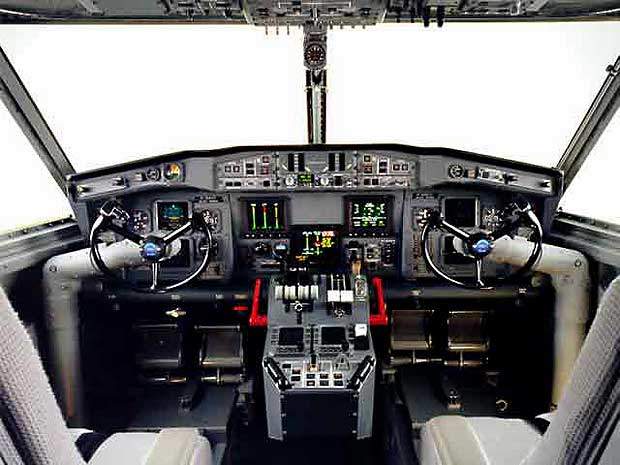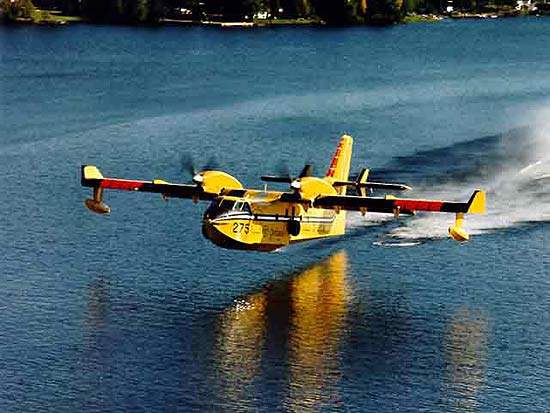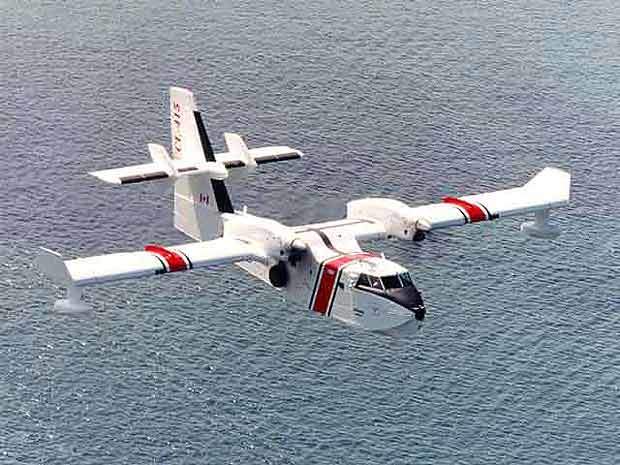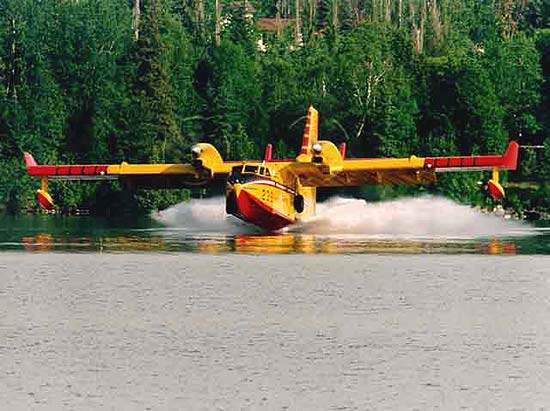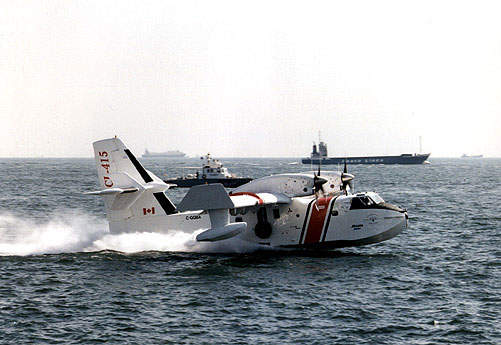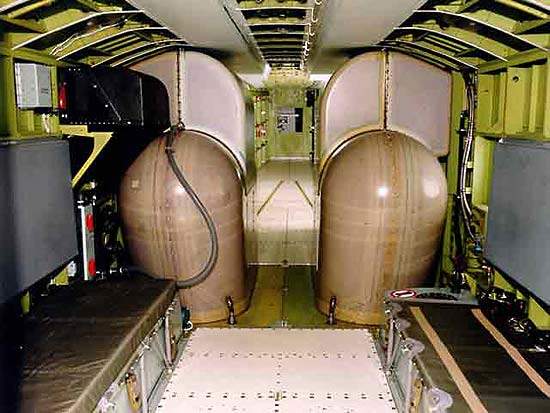The Bombardier Canadair 415 amphibious aircraft was launched in 1991. The aircraft first flew in 1993. 65 aircraft have been delivered to the governments of France (13), Québec (eight), Italy (17), Croatia (four), Ontario (nine), Greece (ten) and Spain (one). The 415 has also been evaluated by the US National Guard.
In November 2007, Croatia ordered a further two aircraft and, in January 2008, Spain ordered an additional two aircraft. In June 2008, the Malaysian Maritime Enforcement Agency placed an order for two 415MP aircraft.
The Canadair 415, well known for its use in the firefighting service as the Superscooper, is also adapted to a variety of specialised missions, such as maritime surveillance, search and rescue and personnel transport. Superscooper is a Canadian and US registered trademark.
The Amphibious Aircraft division of Bombardier, based in Montréal, is responsible for the marketing, sales and product support of the Canadair 415.
Firefighting mission equipment
The layout of the interior of the fuselage for the firefighting variant of the aircraft provides seating for eight crew members on inward-facing four-man folding seats on either side of the forward cabin.
Four water tanks installed in the main fuselage compartment have a combined capacity of 6,137l. A hose adaptor is installed on each side of the fuselage to fill the tanks while the aircraft is on the ground. The tanks are filled in flight while skimming over the water surface via two hydraulically operated scoops, located aft of the hull step.
With the aircraft skimming over a distance of 1,340m (including safe clearance heights), the water tanks can be filled in 12s by the scoops. For safe scoop-filling operations, for example from a lake, the water should have a depth greater than 1.40m.
In a firefighting mission, the Bombardier Canadair 415 aircraft can remain on station for up to three hours, dropping typically nine tank loads of water on a fire, refilling from a water source 10km away.
A foam concentrate / water mixing system is installed in the fuselage with the chemical tanks for the foam concentrate solutions fitted under the two four-man folding seats.
A spray kit can be fitted to the tanks for large area spraying of pesticides, defoliants and oil dispersant chemicals.
415 MP multi-purpose variant
The 415 MP (Multi-Purpose) variant has been developed for a range of roles and missions, including maritime surveillance, and search and rescue. The 415 MP made its maiden flight in March 2002.
Greece placed orders for two 415 MP aircraft for operation by the Hellenic Air Force and the first aircraft was delivered in March 2004. The aircraft, which will be based at the Elefsis Air Force Base, are fitted with a maritime surface surveillance system, Ericsson side-looking airborne radar, a FLIR Systems SeaFLIR forward-looking infrared, a Honeywell Primus 660 weather and sea search radar, rescue beacon transponders, digital imagery, autopilot system and Have Quick secure radios. It can also deploy a jet boat that can carry rapid intervention teams of five at speeds at over 80km/h.
The aircraft can be fitted to carry cargo, passengers, troops and litter (stretcher) patients. The aircraft can be equipped with searchlights, maritime surveillance radar, electro-optical surveillance systems, and mission-specific communications and navigation systems.
415 Superscooper flight deck
The two-pilot flight deck is fitted with a Honeywell EDZ-605 EFIS electronic flight and information system and dual air data computers. The instrument panels have a three-tube integrated instrument display system and an Electronic Attitude Director Indicator (EADI) and Electronic Horizontal Situation Indicator (EHSI). The cockpit is fitted with a Litef / Honeywell Attitude Heading Reference System (AHRS) and a Honeywell radio altimeter.
The navigation suite includes an optional Garmin global positioning system, dual automatic direction finders, VOR/ILS integrated VHF omnidirectional radio ranger and instrument landing system, marker beacon receive units and Distance Measuring Equipment (DME).
The communications systems include Global multiband radio communication set covering VHF/UHF/AM/FM bands, Rockwell Collins HF radios with two transponders and an Emergency Locator Transponder (ELT). The cabin is equipped with a vapour-cycle air conditioner and a combustion heater.
415 Superscooper construction
The CL-415 aircraft, a cantilever high-wing monoplane, was designed around the airframe of the CL-215 aircraft. The CL-415 has a higher operating weight than the CL-215 for increased firefighting capability. The fuselage is a fail-safe all-metal single-step flying boat hull incorporating several watertight compartments.
Stabiliser floats are mounted on pylons on the undersides of the wings near the wingtips. The wings are fitted with endplates to improve the aircraft’s lateral stability. The aircraft is fitted with a powered rudder, ailerons and elevators.
The aircraft has a cantilever all-metal fail-safe tail unit. The horizontal tailpieces are mounted halfway up the vertical fin. The control surfaces of the tail unit are constructed of honeycomb panels and the surface of the tail is aluminium alloy sheet.
Two water scoops are installed behind the planing step. The aircraft has a firefighting drop system composed of four independently openable water doors.
415 Superscooper engines
The aircraft is powered by two Pratt & Whitney Canada PW123AF turboprop engines, each providing a power of 1,775kW. The engines are mounted in damage-tolerant nacelles. The engines drive Hamilton Standard 14SF-19 propellers. The four-bladed constant speed, fully feathering, reversible-pitch propellers are of diameter 3.97m (13ft 0.25in).
The two fuel tanks, with a total usable capacity of 5,796l, are installed in the wing spar box. Each tank comprises a set of eight flexible fuel cells. There are gravity refuelling points on the upper wing and a single pressure refuelling point on the starboard side of the rear fuselage.
Landing gear
The aircraft is fitted with hydraulically operated retractable tricycle-type landing gear. There is the main landing gear well in either side of the hull. A well plate mounted on each of the main landing gear encloses the bottom of the wheel well.
The twin-wheeled nose landing gear is steerable, self-centring and retracts rearwards. The nose unit housing in the hull is enclosed by conformal doors. The tubed nosewheel and the tubeless main wheels are equipped with hydraulic disc brakes.

